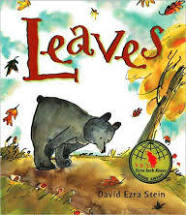

“Margaret Are You Grieving/ Over Goldengrove Unleaving?”
Leaves by David Ezra Stein
Do you remember from childhood, these iconic first lines of Gerard Manley Hopkins and his 1880 poem, entitled “Spring and Fall?
Margaret are you grieving
Over Goldengrove unleaving?
Leaves, like the things of man, you
With your fresh thoughts care for, can you?
Margaret, of Hopkins’ poem, cares with her eager, young and innocent “fresh thoughts” just as dearly for leaves dropping off the trees, as she does for the “the things of man.”
And if young Margaret can, in a poem from 1880, then so can a sweet bear in a picture book published in 2010, called “Leaves” by David Ezra Stein!
Some things are eternally true and transcend the limits of time.
As memories of summer fade and the coloration changes to russet reds and orange, I’ve found one perfect book for the youngest of young readers to welcome the entrance of fall. It’s called Leaves and someone no less than renowned children’s picture book writer, Tomie de Paola, gives it an enthusiastic thumbs up with this review:
“The best picture book I’ve seen in years. The text and illustrations are just perfect – and I LOVE it.”
Both Tomie and David Ezra Stein, who also happens to be winner of the Ezra Jack Keats New Writer Award, have not forgotten what every successful picture book writer must never lose touch with – what it feels like to be a child.
This simple and beautifully illustrated young bear’s experience of the changing of the seasons in the falling of a single leaf, is sweet, innocent and joyful. Its board book format is child-sized, sturdy and will stand up to many readings.
The opening lines are evocative of any child’s first experience with change, be it seasonal or societal:
“It was his first year. Everything was going well
until the first leaf fell. “Are you okay?” he wondered.
Then…a red one fell, a yellow one fell, all over his
island the leaves were falling.”
Even the use of the word “island”, suggests the young bear is experiencing and deciphering this natural yearly phenomenon for the first time – alone.
His is curious, playful and full of the thrill of discovery, as he initially attempts to put them back on the trees and failing that, gathers a bunch to stuff in a hole he finds in which to sleep away the snows of winter.
Mr. Stein’s calm and colorful illustrations, coupled with the young bear’s discovery of the cycle of nature, as he reemerges to the warmth of the sun and the budding of the new leaves on the trees, is quietly reassuring to bear and reader alike.
His dedication tells us where Mr. Stein received his insights into the heart of childhood for they must have been born of a life experience filled with similar forays of discovery and wonder, lead by someone who knew the way:
For my mother,
a bear of great heart
and an exceptional human being.
I believe Gerard Manley Hopkins in his poem, and its direct address opening to the young and innocent Margaret of the poem, realized she, too, was struggling with her first introduction to how nature mimics the inevitable changes in life, and that it can be a mourning of sorts.
Outer childhood may change, but the inner child does not.
Thank goodness that, be it beautiful poetry from 1880 from Gerard Manley Hopkins called “Spring and Fall” or a picture book by David Ezra Stein called “Leaves,” published some 139 years later, we have wonderful prose and poetry that both help young readers to navigate life.
